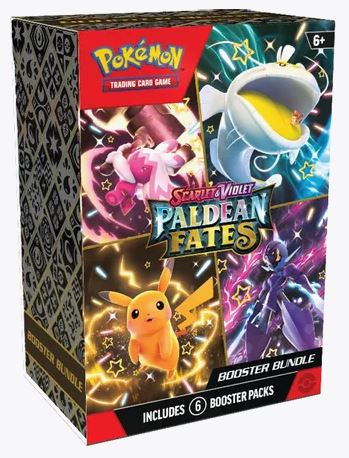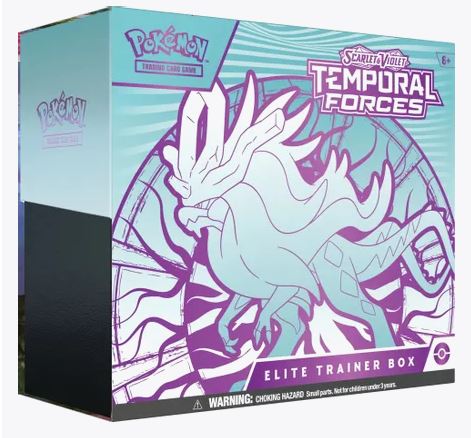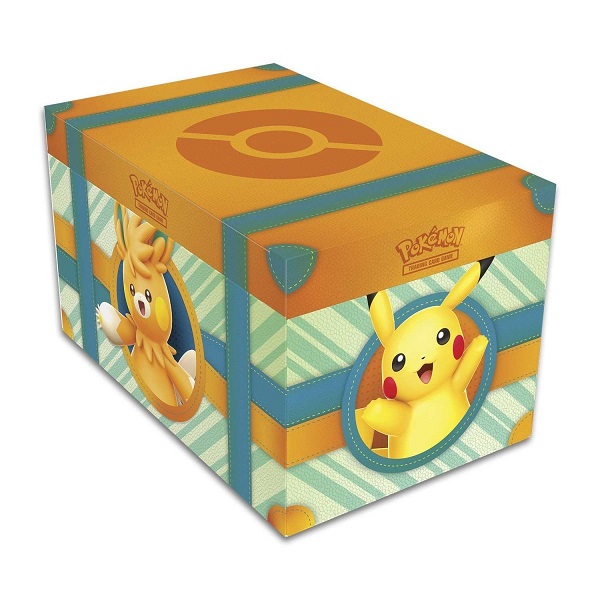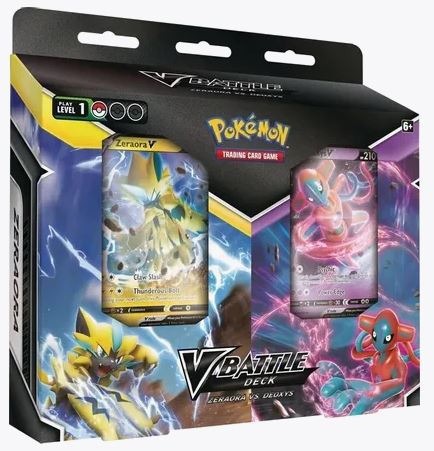Cracking Pokemon: The Trading Card Game packs is a cherished memory, their bright colors and family-friend vibe an easier sell to my parents than Magic’s darker, more violent aesthetic. A first-edition Charizard even sits in an old binder, sadly too dinged up by casual play by our kindergartner selves to attract internet celebrity interest. Nevertheless, flipping coins, attaching energy, and laying waste to friend’s and family’s pocket monster minions made summer days and winter nights a grand time.
internet celebrity interest. Nevertheless, flipping coins, attaching energy, and laying waste to friend’s and family’s pocket monster minions made summer days and winter nights a grand time.
It’s perhaps no surprise, depending on your corner of pop culture knowledge, that Pokemon: The Trading Card Game is going strong. Recent sets like Scarlet and Violet – Paldean Fates tie into the video game series while gently building out the game’s mechanics. Drafts, sealed deck tournaments, and organized play events are widely available. And, for anyone who thinks this is a kids-only game, I encourage you to take a closer look.
There’s meat on these Poke-bones, y’all.
How to Play Pokemon: The Trading Card Game
Translating a popular video game into a card-based battler comes with some strategy-enhancing wrinkles. Much like the video game, you’ll be sending your Pokemon out to smack down the opponent’s monsters, starting with a basic (read: non-evolved) Pokemon, and following up with other critters drawn or evolved. Most will have inherent elements, resistances, and special abilities that you’ll have to judge against whatever Pokemon your opponent fields.
Sending your beloved fire lizard Charmander up against the water-blasting Squirtle didn’t make sense on a Gameboy and it doesn’t make sense here.
Your 60-card, crafted deck supplies both the Pokemon and various support cards to make’em strong. You’ll have energy cards, which are kinda like an equippable version of Magic’s Lands: when attached to a Pokemon in sufficient amounts, they’ll let your beautiful beastie immolate, mentally murder, or vine-strangle your enemy. Trainer and other support cards heal, buff your abilities, and add other game-altering effects, all in service of knocking out your opponent’s team. Each turn, you can play your support cards, attach up to one energy card to one of your Pokemon, and then end with an attack, if possible.
And you want that attack to be strong, because Pokemon: The Trading Card Game is all about the prizes.
 These prizes are six cards pulled from the top of your deck and set aside at the start of each game. For every opposing Pokemon you knock out, you get to choose one of those cards, earning victory with the last one. You’ll also get an immediate win if you knock out every Pokemon your opponent has in play, giving an extra aggressive incentive.
These prizes are six cards pulled from the top of your deck and set aside at the start of each game. For every opposing Pokemon you knock out, you get to choose one of those cards, earning victory with the last one. You’ll also get an immediate win if you knock out every Pokemon your opponent has in play, giving an extra aggressive incentive.
To illustrate: your first drawn seven card hand might hold an Eevee, a Psyduck, three water energy, a healing potion, and a support card that lets you hunt for an evolution. You drop your Psyduck out first, because the bird can take some hits while you go searching for Eevee’s killer evolution. Depending on what your opponent’s playing, and how deadly it is, you might not bother throwing energy on Psyduck at all, instead throwing a water energy on Eevee to make sure it’s ready to wreak havoc in a couple turns. Or, if you’re feeling bold, you’ll give your derpy duck a chance to whack the opponent, dealing damage and inching you closer to those valuable prizes as you end your turn.
With hundreds of monsters, plenty of elementals to mix and match, and evolutions to try and trigger, Pokemon: The Trading Card Game is far deeper than its child-friendly veneer might suggest, and it’s had a vibrant competitive scene for decades. While the moment-to-moment gameplay is easy enough for young children to enjoy, you can . . . evolve (sorry) with your friends or game store group to reach taut back-and-forth duels.
How to get into Pokemon: The Trading Card Game
Much like the video games, and any long-running trading card game, Pokemon has grown over its twenty-year run into a flashy experience that might seem intimidating for any newcomer. And with set names like Pokemon Sword & Shield: Brilliant Stars you might be forgiven for taking a side-eyed approach. Push past the names, though, and you’ll find getting into the Pokemon Trading Card Game is both easy, and rewarding.
First, check out the Pokemon Trading Card Game: My First Battle boxes. These aren’t enough to play a complete game, but for a taste of gameplay, these are an inexpensive gift for yourself or anyone else. You can also find a YouTube channel’s worth of How To Play videos.
Once you’ve caught your first cards, there are a wide swath of pre-constructed deck experiences, including, for those wanting to indulge in 90s nostalgia, a complete set of the original printing to get your collection rolling. Start there, then indulge in a pack or two for fun. Spin up some battles against friends and family, honing your deck construction skills. Then you can aim to clash at high levels or just give Magikarp the spotlight his splashy talents deserve.
 When you’re ready to take your Pokemon out in public, check with game stores in your area to see when they’re holding Pokemon nights, whether it’s tournaments, new set release events, or casual play nights where you can test your pocket monster mettle. Drafts, especially, are inexpensive opportunities to grow your collection while smoothing out skill gaps. You’ll make new friends, find a friendly community—and one uniquely suited, too, for a younger audience—and learn new ways to play.
When you’re ready to take your Pokemon out in public, check with game stores in your area to see when they’re holding Pokemon nights, whether it’s tournaments, new set release events, or casual play nights where you can test your pocket monster mettle. Drafts, especially, are inexpensive opportunities to grow your collection while smoothing out skill gaps. You’ll make new friends, find a friendly community—and one uniquely suited, too, for a younger audience—and learn new ways to play.
Pokemon: The Trading Card Game Formats
Pokemon: The Trading Card Game delivers its cards in sets four or five times a year. To keep the playable card library from getting ginormous, you can play the game in various formats, much like Magic. In other words, when you’re venturing forth to your local store, check the event’s format to make sure your  Charizard isn’t blocked.
Charizard isn’t blocked.
That said, these formats give you good guardrails. They’ll include a ban list, stripping overpowered cards or unexpected, fun-ruining combos from the game. Refreshing allowed cards also lets newer players jump in without getting clobbered by folks with older collections. And, of course, it keeps existing players interested and entertained by tossing in new Pokemon, new effects, or both. That new sets are also, you know, necessary to keep the game profitable is . . . certainly a factor.
Regardless, when you’re looking to attend a Pokemon event, here’s what to watch for:
- Standard – the official format. Standard, like with Magic and other trading card games, targets newer sets, rotating older ones out as new sets are released. Pokemon notes this by a small letter in the lower left hand part of the card, called a regulation mark. If the card has a letter matching the sets in standard, you’re good to go. You can always find what sets are in regulation at Pokemon.com.
- As with all sets, make sure to check the ban list too!
- Expanded – Standard, but without the rotation. Starting from the Black & White base set and on, Expanded lets you go wild (excepting the ban list). There’s no rotation to worry about. If you’ve a solid collection already or want to dabble in older cards, this is the format to look for. Just note that any pre Black & White cards still won’t be legal (though they’re just fine for ad hoc tournaments with friends and family!).
- Pauper – Only common and uncommon cards allowed! So named because it keeps the deck-building costs low, Pauper’s a great way to get creative with your strategies, or find some time for those Magikarp to get coveted deck space.
- U150 – A version of Magic’s Commander format, you’ll be building a 100 card deck that, outside of basic energy cards, only has a single copy of each card inside it. That Pikachu army won’t fly here. The unofficial rules also forbid Pokemon with more than 150 health, meaning you’ll see more variety and less gargantuan monsters.
- Gym Leader Challenge – Similar to U150, Gym Leader Challenge further restricts your singleton deck to a sole color, challenging you to dive deep into your favorite Pokemon types and craft something fun. Is it a life goal to build a lightning deck and repeatedly refer to myself as Lieutenant Surge in a tournament match? I’ll never tell.
All these options just give you more ways to play, whether at home with friends, family, or your local game store. With any collectible card game, there’s a risk of winding up with a giant box filled with cards that aren’t viable in tournaments, have been rotated out, or forgotten. Variants like these give you a reason to dust off some memories and take them out again, sometimes stumbling on unforeseen combos or just reveling in a pure, whacky game with every set shoved together.
Cracking Packs and Picking Prizes
Venerable, splashy, and with strategy to match your desired difficulty—look, you might not win with Magikarp, but it’s about the journey, amiright?—Pokemon: The Trading Card Game remains as viable today as it was when it launched a couple decades ago. For every article hyping up those first edition Charizard prices, there’s another story that goes untold: the smiles as a sibling lands a key evolution on the kitchen table, a deck you built scores some prizes in a local tournament, or a draft night that leads to laughs when a wild strategy pays off.
Charizard prices, there’s another story that goes untold: the smiles as a sibling lands a key evolution on the kitchen table, a deck you built scores some prizes in a local tournament, or a draft night that leads to laughs when a wild strategy pays off.
The original Pokemon video game made magic with its merry, superpowered critters. Its cardboard sibling is still doing so, and shows no signs of stopping. So if you’re looking for a new adventure, grab some pokeballs and get to capturing (you know what I mean).
